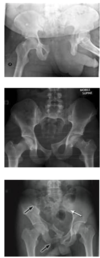3. Trauma Flashcards
How many UK deaths/yr are attributable to trauma?
What is the (C)ABC of a primary survey of a trauma patient, and what things may need to be done at each stage?
At what GCS will a patient need some sort of airway intervention?
18,000. Leading cause of death in <50yo. 1/3 preventable.
1. Catastrophic haemorrhage control e.g. tourniquet
2. Airway: O2 and C-spine? Simple manoeuvres, adjuncts, jaw thrust, Guedel/oropharyngeal/nasopharyngeal, COETT (cuffed oral endotracheal tube), surgical airway?
3. Breathing: resp rate, effort, O2 sat, look and feel, percussion, auscultation, tracheal deviation, chest wounds/expansion?
4. Circulation: pulse rate and strength, central + peripheral pulses, cap refill (central + peripheral), colour, sweaty, BP, distal perfusion
8 or below
What is included in the secondary survery of a trauma patient?
What blood tests would you do for a patient in trauma?
1. Disability: AVPU, GCS (3-15/15, eyes, verbal, motor) [pic]
2. Exposure and environment
3. Radiographs: plain (chest, pelvis, limbs), eFAST (extended focussed assessment with sonography for trauma)
4. CT(A)
Then tertiary survey
FBC, U+E, G&S (group and save - pt’s blood is typed and tested for abs), XM (cross match - typed and tested, then matched to specific units of blood for transfusion), ABG (BD (base deficit - nonspecific indicator of metabolic acidosis), lactate (high in most trauma pts), pH)

Explain the handover accronym for trauma patients.
What would be the management for the following patient?
45yo male, one hour ago, ped vs. car, head injury, snoring, unresponsive, HR 80, BP 110/70, O2, collar, cannula, transfer
And later for the same patient:
R pupil is 6 and unreactive, GCS <8, CT head shows extradural haemorrhage
What would be the management for the following patient?
17yo male, 20 mins ago, single stab to R chest, HR 130, BP 90/40, RR 30, O2, dressing, IV morphine, 1L fluid. CXR [pic]

ATMIST: age, time, mechanism, injuries, signs and symptoms, treatment
Airway: adjuncts, oro/nasalpharyngeal, COETT? CT head. Cushing’s triad for traumatic brain injury: agonal breathing, bradycardia, hypotension = impending brainstem herniation! Middle meningeal artery most likely suspect for epidural bleed [pic]
OR (operating room) - burr hole to remove clot/crainectomy and give mannitol to reduce swelling
Can see pneumothorax - put in chest drain. Decompression, ICD?

What would be the management for the following patient (incl. pelvis and limb outcomes)?
21yo female, 90 mins ago, cyclist under lorry, graze over abdomen - peritonitic, FAST +ve, deformed pelvis and thigh swelling, HR 130, BP 85/60, RR 28, O2, IV, 1.5L fluid, pelvic binder, kendrick splint
What would be the (vascular) management for the following patient? Which vessel is most likely affected in his thigh?
25yo, 40 mins ago came off bike, penetrating injury to L thigh, bleeding +++, HR 140, no palpable BP, dressings to wound
DCS (damage control surgery??), DCR (PRBC, FFP, warm, TEG, TXA etc.), laparotomy.
Pelvis: open book, vertical sheer, lateral compression [pic, top to bottom]. Mx: binder, fix, embolisation, theatre.
Limbs: open/closed? Reduce, painful, blood loss
Profunda femoris most likely affected b/c lateral. Temporary control e.g. tourniquet. If small vessel bleed then leave. If large then embolise -> surgery

What would be the management for the following patient?
HEMS doc, called to 21yo male, stab to chest/abdomen in cardiac arrest
What is the accronym to use for major incidents?
Cardiac arrest: resuscitative thoracotomy
METHANE: mechanism, exact location, type, hazards, access, number, equipment


